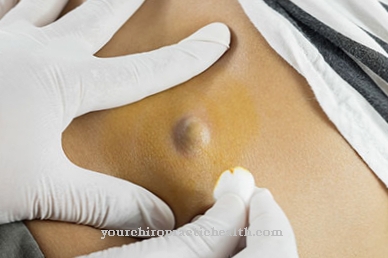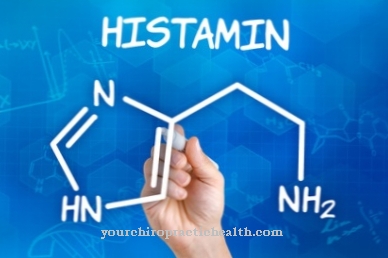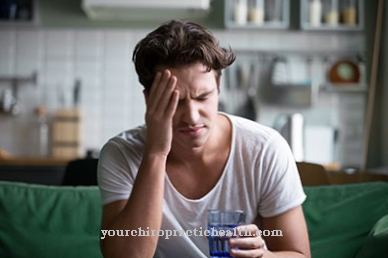A Puerperal mastitis is an inflammation of the milk-producing (lactating) breast, which is caused by a bacterial infection and is the most common complication during breastfeeding, along with congestion. Puerperal mastitis affects roughly one in a hundred women after giving birth, although the disease is usually easy to treat.
What is puerperal mastitis?
.jpg)
© designua - stock.adobe.com
As Puerperal mastitis is an acute inflammation of the mammary gland during breastfeeding, which is due to bacterial pathogens (over 90% to Staphylococcus aureus).
Depending on the type of spread, a distinction is made between two forms of puerperal mastitis. In most cases, puerperal mastitis spreads diffusely in the connective tissue of the breast via the lymphatic system or the blood (interstitial puerperal mastitis).
In addition, puerperal mastitis can spread via the milk duct system of the affected breast, with the transmission primarily taking place during breastfeeding.
Breast infection while breastfeeding is extremely painful and should be examined and treated by a doctor. A first relief can be achieved with cooling compresses.
causes
A Puerperal mastitis is triggered by a contamination with a bacterial pathogen, which usually comes from the germ-colonized nasopharynx of the child. The child may have been infected by the mother or by hospital staff (nosocomial infection).
In addition, contamination as a result of contact between the breast skin and the lochia classified as infectious (wound secretion after birth) is possible. The pathogens enter the breast via rhagades (fine cracks) in the nipple (nipple), the areola or the skin during breastfeeding, spread and trigger puerperal mastitis.
Furthermore, mastitis puerperalis can be caused by a blockage of the milk, in which the multiplication of the pathogens can also be favored, similar to a "standing water".
Symptoms, ailments & signs
Symptoms of breast inflammation during breastfeeding can be varied. At the beginning, the inflammation will become noticeable through an increased feeling of tension in the entire breast. These tensions will gradually develop into more severe pain. The chest will swell and be harder than normal. You will also notice reddening.
Because the chest is inflamed, it will feel hot. In connection with this, a fever can appear like "out of nowhere". Furthermore, affected women often suffer from sweats and circulatory problems. Many feel sick and exhausted. The affected breast will also increase significantly in size. These symptoms usually only appear once during breastfeeding. However, in some cases it can relapse.
In rare cases, mastitis leads to the development of encapsulated collections of pus (abscesses). In the worst case, this can lead to fistulas. Through these fistulas, pus can penetrate into surrounding tissue, under the skin or even into organs. In this case, touching the diseased chest is almost unbearable.
Cooling compresses have a soothing effect. The symptoms described should have subsided after two weeks at the latest. If this is not the case, a doctor should be consulted.
Diagnosis & course
At a Puerperal mastitis the diagnosis is made during a clinical examination. Painful swelling in the area of the affected mammary gland accompanied by reddening, overheating of the skin as well as sudden fever, body aches and swollen axillary lymph nodes are characteristic symptoms of puerperal mastitis.
The diagnosis is confirmed by a blood analysis, which is used to test the blood for inflammation markers. In some cases (4-12%) of puerperal mastitis, an abscess (accumulation of pus) forms within 1 to three days. If abscess formation is suspected, sonography (ultrasound examination) is required to determine the size and location of the abscess.
In general, the course of puerperal mastitis is good and the inflammation resolves itself quickly or with the treatment. However, if puerperal mastitis was already present, the disease can become chronic and the risk of recurrent puerperal mastitis is increased.
Complications
A breast infection during breastfeeding is usually very uncomfortable and leads to burning pain and other restrictions. In order to avoid consequential damage, treatment by a doctor is definitely necessary. Those affected mainly suffer from fever while breastfeeding. In addition to the fever, there is also tiredness and fatigue.
The mother's breasts become inflamed, causing pain and uncomfortable feelings in the chest. Especially when breastfeeding, there is severe pain. The breasts can also enlarge or swell during breastfeeding due to the breast infection. Furthermore, there are the usual symptoms of the flu, so that the patients suffer from headaches and body aches. The quality of life is significantly reduced by this disease.
In many cases, however, breast inflammation does not lead to further complications while breastfeeding and disappears on its own. Treatment is rarely necessary. However, this is carried out with the help of antibiotics and does not lead to further complications. The life expectancy of the patient is also not affected by breast inflammation during breastfeeding.
When should you go to the doctor?
Puerperal mastitis occurs only in women after giving birth and during breastfeeding. If there is pain or changes in the skin of the breast, a doctor should be consulted. Pain reliever medication should only be taken in consultation with a doctor, as they can lead to complications for both the mother and the baby. Any swelling in the breast or nipple should be assessed by a doctor. If the mother refuses to breastfeed the baby because of the existing symptoms, a doctor should be consulted. It must be ensured that there are no impairments or deficiencies in the care of the newborn child.
If the mother has a fever, general malaise or sweats, a doctor is required. If there are irregularities in the heart rhythm or a breakdown of the circulatory system, it is advisable to have the complaints clarified by a doctor. The formation of pus, the development of lumps or fistulas on the breast must be examined and treated. If the mother suffers from anxiety, rejects her child or if other emotional irregularities arise, a doctor or therapist is needed. A doctor should be brought to the attention of a doctor if you feel less well-being, mood swings or abnormal behavior. These are signs of a health disorder that need to be investigated and treated.
Treatment & Therapy
At a Puerperal mastitis physical measures are applied first. This includes cooling and consistent emptying of the breast to avoid milk congestion. In addition, the milk production can be reduced with drugs using prolactin inhibitors.
Furthermore, the affected breast should be immobilized if possible. If no improvement can be seen within 24-48 hours, antibiotic therapy is recommended. Since around 80 percent of the strains of Staphylococcus aureus are resistant to penicillin, a doctor will take a smear to determine an antibiotic to which the pathogen is not resistant. If an abscess has formed in the further course, the doctor can empty the abscess through an incision (minimal skin incision) by placing a tab or a small tube into the abscess cavity to drain off the wound secretion (suction-irrigation drainage).
Daily wound irrigation is required until the puerperal mastitis has completely subsided. If only smaller subcutaneous abscesses develop in the course of puerperal mastitis, these can be punctured and the wound secretion sucked off with the help of a syringe. While breastfeeding can continue after the first two days with mild puerperal mastitis, breastfeeding should be avoided in any case with abscessing puerperal mastitis.
Outlook & forecast
The prognosis of breast inflammation during breastfeeding is favorable. Spontaneous healing is often documented in many of those affected. Medical care should take place so that no secondary disorders or long-term complications occur. In the company of a trained doctor, different approaches to alleviate the symptoms are pursued.
In a large number of cases, immobilization of the breast is sufficient to improve the overall situation. In addition, the breast should be cooled and breast milk should be emptied completely. If there is no improvement within a few days, the administration of medicines will initiate a decline in milk production. As soon as the organism stops producing milk after birth, the irritation can completely heal. Since the disease is triggered by bacteria, active ingredients are administered that are aimed at killing the pathogens. They are then removed from the organism and excreted.
If the disease progresses well, after a few days of rest you will be free of symptoms. If an unfavorable course develops, a recovery can be expected as soon as milk production has ended. A few days or weeks after the inflammation has completely healed. If breast inflammation occurs again after a new pregnancy, the prognosis is also favorable.
prevention
Adequate skin care for the breast to avoid flaws (ointments, creams) can be used during breastfeeding Puerperal mastitis prevent. Regular and careful emptying of the breast can also help prevent milk congestion by reducing the risk of congestion. In addition, direct contact of the breast with lochia should be prevented to avoid puerperal mastitis.
Aftercare
Puerperal mastitis can recur at any time after it has healed, which is why it is important to specifically control the milk flow immediately afterwards. Above all, it is crucial to ensure that the chest is emptied as much as possible. If the child has not drunk everything, it can help to spread out the remaining milk in order to avoid a new build-up. Follow-up care is therefore more focused on preventing breast inflammation.
Once invading germs have settled in the pent-up breast milk and caused an infection, further complications can result. It is important to normalize the changed drinking behavior of the child as quickly as possible. In the event that this does not seem feasible, an alternative is to switch to bottle feeding so that the child does not suffer from dehydration and lack of nutrients.
You can do that yourself
With puerperal mastitis or breast inflammation while breastfeeding, there are some measures that the person can take themselves to alleviate the symptoms and cure the inflammation.
First of all, a well-fitting bra is an advantage if you develop breast infections. Furthermore, a warm compress can be placed on the breast before each breastfeeding. Due to the warmth, this stimulates the flow of milk. During the time between breastfeeding, cooling the breast with the help of ice packs or curd compresses can improve the inflammation. Also wraps with acetic acid clay can lead to cooling and thus to an improvement. The breast should be emptied regularly so that there is no build-up of milk in the breast. In addition, the person concerned should ensure that they drink sufficient fluids. It is also important to ensure bed rest.
If the puerperal mastitis is too severe, the affected person can often not breastfeed due to pain. A doctor should be consulted who will prescribe medication that may not harm the infant. If there is no improvement in puerperal mastitis after using the self-help measures mentioned, a doctor should be consulted, who then usually begins treatment of the breast inflammation with antibiotics.



.jpg)
.jpg)




















.jpg)


